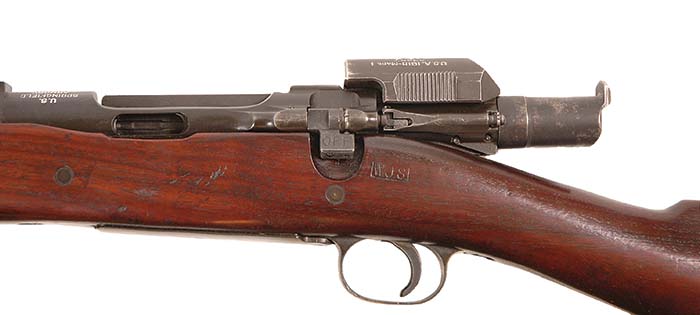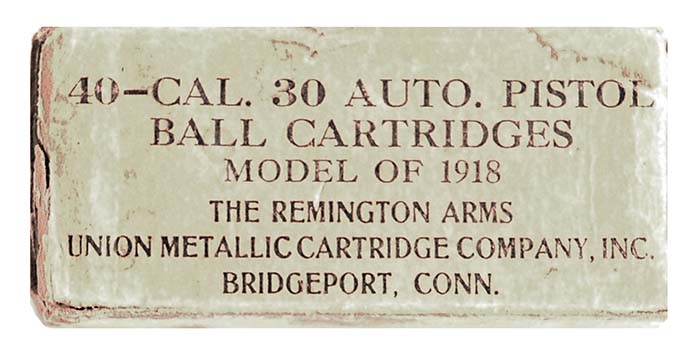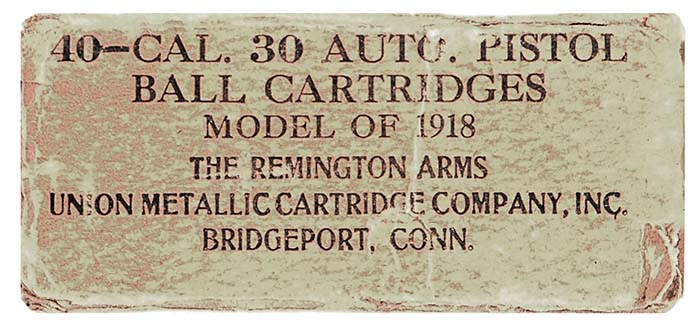The Top Secret Pedersen Device installed in a Mark I U.S. 1903 Rifle.
By Frank Iannamico
World War I began on 28 July 1914 and lasted until 11 November 1918. The underlying cause of the war was a complex series of political, territorial and economic problems. The stage for war was set on June 1914 with the assassination of Archduke Franz Ferdinand of Austria. Within weeks, the major powers were at war, and the conflict quickly spread around the world. Initially the United Kingdom, France and the Russian Empire were fighting with the Central Powers of Germany and Austria-Hungary. Before long Italy and Japan joined the Allies while the Ottoman Empire and Bulgaria joined the Central Powers.
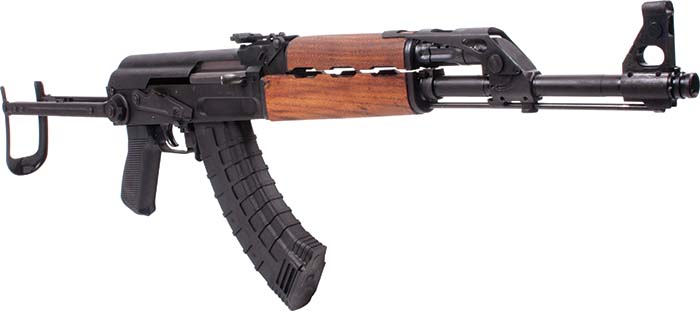
By early 1915, the fighting had reached an impasse on the Western Front. Artillery barrages, along with water-cooled machine guns, made crossing open ground impossible. Massed infantry advances on enemy positions became suicidal. Armies had not developed infantry tactics for breaching entrenched positions without suffering heavy casualties. However, new offensive weapons, such as gas warfare and the tank designed to break the stalemate began to appear on the battle field.
On 2 April 1917, U.S. President Woodrow Wilson asked a special joint session of Congress to declare war on the German Empire. On 6 April 1917, Congress declared war on Germany on the grounds that Germany violated U.S. neutrality by attacking international shipping.
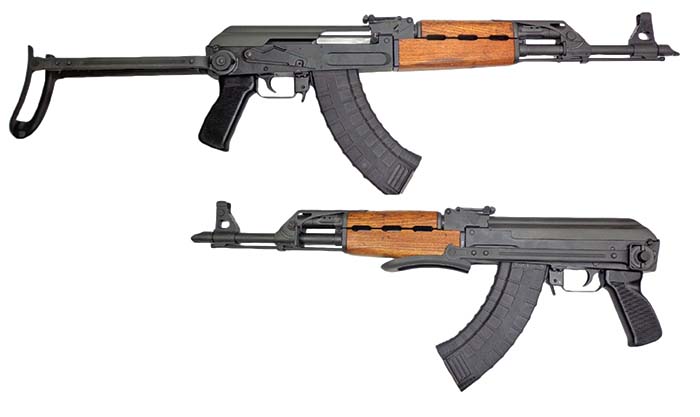
The United States’ Secret Weapon
Development of the Pedersen Device began in late 1916 at the Remington Arms Division in Ilion, New York by John D. Pedersen aided by long-time associate and tool designer Oliver H. Loomis. By the spring of 1918 a working prototype was ready. Pedersen contacted the Army’s Chief of Ordnance William Crozier to arrange a demonstration of his Device. Mr. Pedersen was well-known and respected by the Army Ordnance Office and his request was granted. The demonstration was held on 8 October 1917 in Washington, DC at the Congressional Heights rifle range, with only a few high ranking officers and Congressmen invited to attend. On the firing line Mr. Pedersen produced a modified 1903 bolt-action rifle (reportedly serial number 789300 owned by Pedersen) and began to fire the weapon in its original .30-06 configuration. He then removed the rifle’s bolt and replaced it with a strange object, which was removed from a scabbard attached to his belt. Pedersen inserted a magazine into the rifle and began to fire 40 rounds semiautomatically down-range in rapid succession. Those witnessing the demonstration were duly impressed by the volume of fire produced by Pedersen’s Device. A few months later one of the Devices was shipped to France for evaluation by General Pershing. On 9 December 1917 a board was convened at Langres, France to evaluate Pedersen’s “secret weapon.” The Device was tested for accuracy, penetration, rate of fire and reliability. It was quickly determined that turning the 1903 rifle into a short range rapid-firing semiautomatic weapon, while retaining its bolt-action ability to fire at long range targets had merit.
Convinced of its potential, General Pershing requested 100,000 of the Devices and modified 1903 rifles to use them. The initial order was placed with Remington Arms Company on 26 March 1918. To conceal the true purpose of the top-secret Device it was designated as the Automatic Pistol, Caliber .30, Model of 1918, after its official adoption.
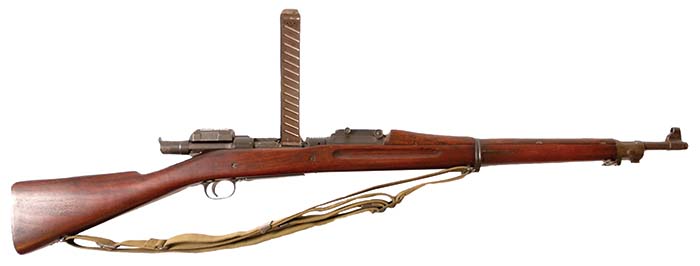
Automatic Pistol, Caliber .30, Model of 1918 Mark I
One of the secret weapons of World War I developed by U.S. arms designer J.D. Pedersen was a device designed to convert the issue U.S. 1903 bolt action service rifle into a semiautomatic weapon. The device was a blow-back design that fired specially developed .30 caliber pistol rounds semiautomatically from a modified 1903 rifle. The “barrel” of the Device was in the shape of a .30-06 cartridge that fit into the 1903 rifle to fill the chamber. The “barrel” of the Device had an internal chamber for the small cartridge, and was rifled with lands and grooves to start the bullet spinning as it entered the 1903’s barrel. The device was designed to replace the 1903’s bolt and could be installed by the soldier in the field in as little as 15 seconds. The Device and its scabbard weighed 2.12 pounds. The rifle could just as easily be restored to function in its original .30-06 configuration by removing the device and installing the original bolt assembly.
The Magazine
The Pedersen Device fed from a double-stack, double-feed 40-round magazine that extended vertically from the 1903’s receiver, and was positioned at a 45-degree angle so that the rifle’s sights could be used. The magazine was retained in the Pedersen Device by two spring actuated fingers that engaged projections on the magazine. The sheet-metal magazine’s body had strengthening ribs pressed into its side.
The back of the magazine that faced the soldier firing the weapon had a series of holes, in 5-round increments, designed to indicate the number of rounds in the magazine. A loaded magazine weighed 1-pound. Soldiers were to be issued ten magazines for a total of 400 rounds, carried in two canvas pouches attached to the cartridge belt. Production of the 40-round magazines was subcontracted out to the Oneida Limited, Mount Vernon Silversmiths and an unknown contractor using the manufacturers’ code TP. An estimated 1.6 million magazines were manufactured for the Pedersen Device.
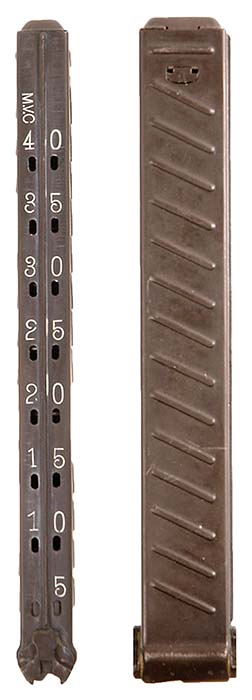
The stamped steel magazines had a 40-round capacity. The back had “witness” holes in 5-round increments. The contractor’s initials M.V.C. are stamped at the top. The magazines for the M1917 Rifle’s Mark II Device were slightly different.
Accoutrements
There were several accessories designed to be issued with the Pedersen Device. To carry the Device itself a stamped metal scabbard, with a hinged top secured by a wire bale, was provided. Hooks were used to attach the scabbard to the metal eyelets in the cartridge belt. A canvas pouch was also supplied to contain and store the 03’s bolt when the Device was installed in the rifle. A 5-cell canvas magazine pouch was designed to hold the magazines. Two or three pouches were to be carried attached to the cartridge belt. The magazine pouches were produced at the Rock Island Arsenal and ink-stamped R.I.A. and date of manufacture. Two identical stamped steel wrenches were provided to adjust the Device’s barrel to ensure a snug fit in the host rifle. The complete Pedersen Device, accessories and ten loaded 40-round magazines added 14-pounds to the soldier’s basic equipment.
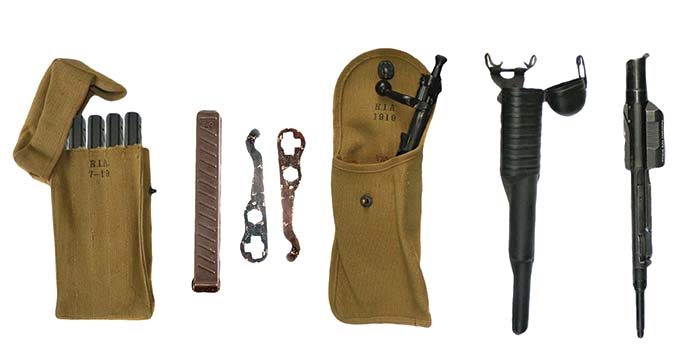
Caliber .30 Auto-Pistol, Ball Cartridge, Model of 1918
Ammunition for the Pedersen Device was a comparatively small .30 caliber pistol round with an 80 grain bullet and a 3.5 grain powder charge. Fired from a Pedersen Device in a 1903 Rifle the bullet had a muzzle velocity of 1,300 feet per second, though far less powerful than the M1906 .30-06 service cartridge, it was estimated that the 80 grain bullet would be lethal at ranges up to 400 yards. The primary advantage of the Pedersen Device was of course volume of fire.
The cartridges were produced by the Remington Arms Company, Bridgeport, Connecticut. Most of the brass cartridge cases were manufactured at Remington’s Hoboken, New Jersey plant and then shipped to their Bridgeport factory for loading and packing. The rounds were packed 40 to a box (the Device’s magazines each hold 40-rounds) 5 boxes to a carton. Cloth bandoleers were produced to hold three of the 200 round cartons. The cartridge cases were head-stamped: RA 18, RA H18, RA 19 or RA H19. RA=Remington Arms, H=Hoboken, New Jersey plant 18 or 19 the year of production.
An experimental cartridge for the Pedersen Device was developed to enhance its lethality. The cartridge featured a 90 grain bullet with a muzzle velocity of 1,490 feet per second, but the round’s overall length was too long to fit in the original magazines.
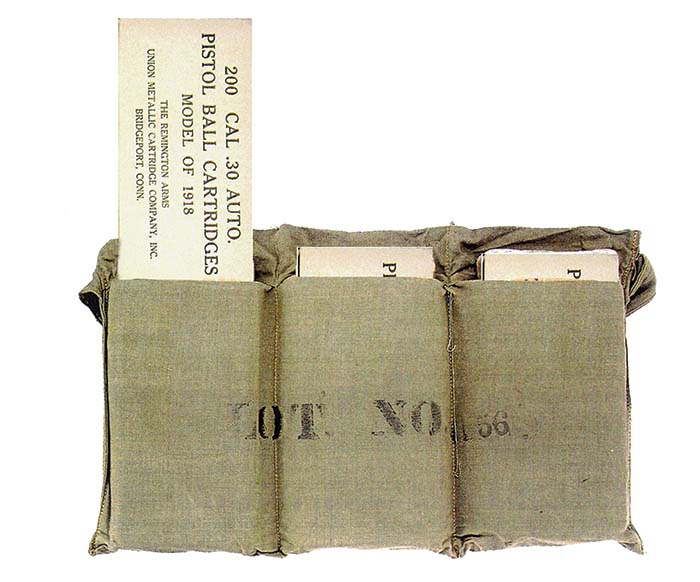
The 1903 Mark I Rifle
Modifications to the standard issue M1903 Rifle to the Mark I configuration required to accommodate the Pedersen Device included the following:
- Receiver: The receiver had an oval port milled out of the left side to line up with the ejection port of the Pedersen device allowing the spent case to be ejected from the Device and the rifle. The receiver ring was roll-marked with the Mark I nomenclature to indicate the
- rifle’s modifications.
- Sear: The sear was modified to include a pivoting trip lever designed to trigger the Pedersen Device.
- Trigger: The 03’s trigger was altered with a light relief cut on its rear upper surface to allow function of the Mark I’s trip lever.
- Cut Off: The magazine cut-off was redesigned to secure the Device in the rifle. The body of the cut-off was relieved to engage machined cuts in the Device securing it when the lever was placed in the “off” position. There were two different types of cut-off alterations.
- Early production had two retention grooves while later manufacture only had one.
- Cut-Off Spindle: The cut-off spindle was reconfigured to add a small spring and plunger into its forward end to apply pressure to the Device’s safety. The rear of the spindle had a slot for a screw driver to aid in assembly. The cut-off screw seat is a single hole in the Mark I spindle, in place of the radial slot on the original design.
- Stock: The stock had a slight relief cut on its rear upper surface in line with the ejection port.
The Mark I rifle could still function normally as a bolt-action rifle and fire .30-06 cartridges when the Device was replaced by the original bolt assembly. In its modified form the Mark I rifle weighed 9.25 pounds. The Mark I barrel had four-lands and grooves with a 1 in 10 inch twist.

Automatic Pistol, Caliber .30, Model of 1918 Mark II
When the U.S. entered World War I there were not enough 1903 rifles to equip the rapidly expanding U.S. Army. Prior the United States’ entry into World War I Great Britain contracted with several U.S. companies to manufacture its .303 caliber
Pattern 14 rifle.
To supplement 1903 rifle production the Ordnance Department decided it would save both time and money by adapting the British rifle to accept the U.S. .30-06 cartridge, rather than re-tool the factories making the Pattern 14 factories to produce the standard U.S. rifle, the M1903 Springfield. Accordingly, Remington Arms Co. altered the design for caliber .30-06, under supervision of the U.S. Army Ordnance Department, which was formally adopted as the U.S. Rifle, Caliber .30, Model of 1917. The production of Model of 1917 rifles far exceeded 1903 production, and thus issued in larger numbers to U.S. soldiers. Because of the numbers of the Model of 1917 rifles being issued it was decided to design and manufacture a Pedersen Device for the weapon designated as the Automatic Pistol, Caliber .30, Model of 1918 Mark II. Few were ever produced before the war ended.
In addition to the Mark II Device for the Model of 1917 rifle, a third model of the Pedersen Device was planned for the Russian Mosin Nagant rifle. However, after the Communists overthrew the Czarist government, a treaty was negotiated with Germany, and on 3 March 1918 Russia pulled out of the conflict. As a result there was no production of the Device for the Russian rifle, other than tool room models.
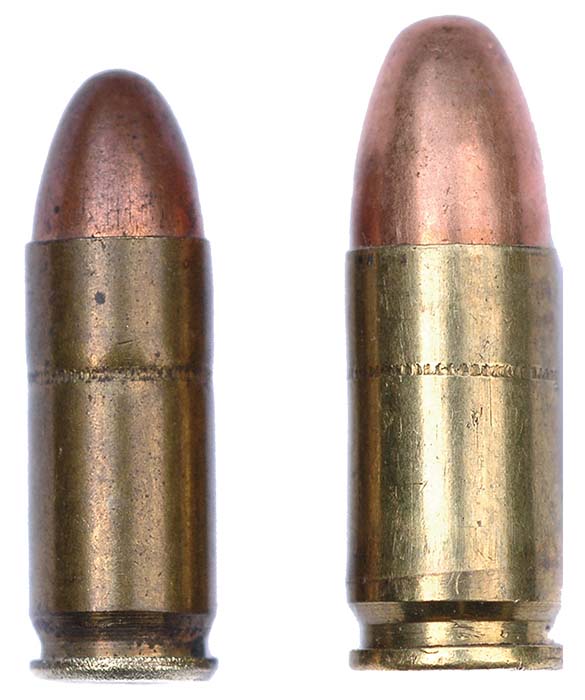
Tactics
The Pedersen Devices was believed to have potential as both an offensive and defensive weapon. Commanders envisioned their soldiers crossing no-man’s land firing their 1903 rifles fitted with the Pedersen Device, saturating the enemy position with a hail of bullets. It was also theorized that the Pedersen Device as a defensive weapon, which could be used to repeal a close quarters attack on their positions. The secret Device was to be revealed to the enemy during a massive offensive planned for the spring of 1919.
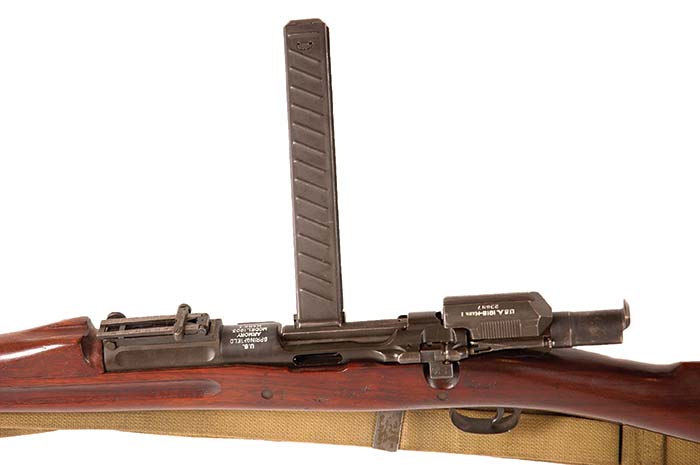
The War Ends
An Armistice was declared on 11 November 1918 ending World War I before any of the Pedersen Devices reached the troops in the field. But production of the Pedersen Device continued until 1 March 1919 when the contract was cancelled. At the time of the contract cancellation there were a reported 65,001 Devices and 65 million rounds of .30 caliber ammunition produced. Production of the 1903 Mark I rifles continued at the Springfield Armory with a production figure of 91,750 rifles in fiscal 1919, and an additional 10,025 in fiscal 1920. The 101,775 modified 1903 Mark I rifles and 65,005 Pedersen Devices and accouterments were then placed in storage as war reserves.
J.D. Pedersen
John Douglas Pedersen (May 21, 1881 – May 23, 1951) was a prolific arms designer who worked for Remington Arms, and later for the United States Government. He would be best known for his Pedersen Device that never fired a shot in anger.
Although Pedersen had success with many firearms for the commercial market, his timing always seemed to off when it came to military weapons. The U.S. Navy recommended adoption of his .45 pistol design, but Pedersen’s design was shelved in favor of the M1911 pistol already in production for the army. His semiautomatic rifle and accompanying .276 caliber cartridge were passed over in favor of John Garand’s rifle.
During World War II Mr. Pedersen formed The Irwin-Pedersen Arms Company financed by the Irwin family of Michigan. Primarily through Pedersen’s contacts in the Ordnance Department, the Irwin-Pedersen Arms Company received a contract to manufacture M1 Carbines. Unfortunately, the company failed to achieve mass production and produced slightly over 3,500 M1 Carbines. None of the carbines met Ordnance Department standards and thus were not accepted by the military. In March 1943, the Ordnance Department cancelled the carbine contract it had with the Irwin-Pedersen Arms Company.
During the post-war years the Pedersen Device was reevaluated. Tests were conducted in 1919 and 1920. Approximately 4,000 Mark I 1903 Rifles fitted with Pedersen Devices were shipped to the Panama Canal Zone in 1920 for field testing. All involved in the testing came to the same conclusion: the Device and associated accessories were cumbersome and heavy and its cartridge underpowered. Realizing that the Device had no future in the Army, and reportedly to keep them out of the hands of the growing number of “motorized bandits,” during April of 1931, it was decided to scrap the all of the Pedersen Devices rather than keep them in storage.

Advanced Collector’s Item
Apparently, the government was unusually efficient in destroying nearly all the Pedersen Devices as very few still survive today. Even rarer than the Devices themselves are the thin sheet metal scabbards. While magazines are not especially common, they are not impossible to locate. Ammunition is scarce, but like the magazines can sometimes be found. The canvas bolt pouches and magazine pouches are fairly common and often in unissued condition.
Complete Pedersen Devices and acouterments are generally offered at auction, and depending on condition, bring low to mid five-figure bids.
| This article first appeared in Small Arms Review V19N4 (May 2015) |



